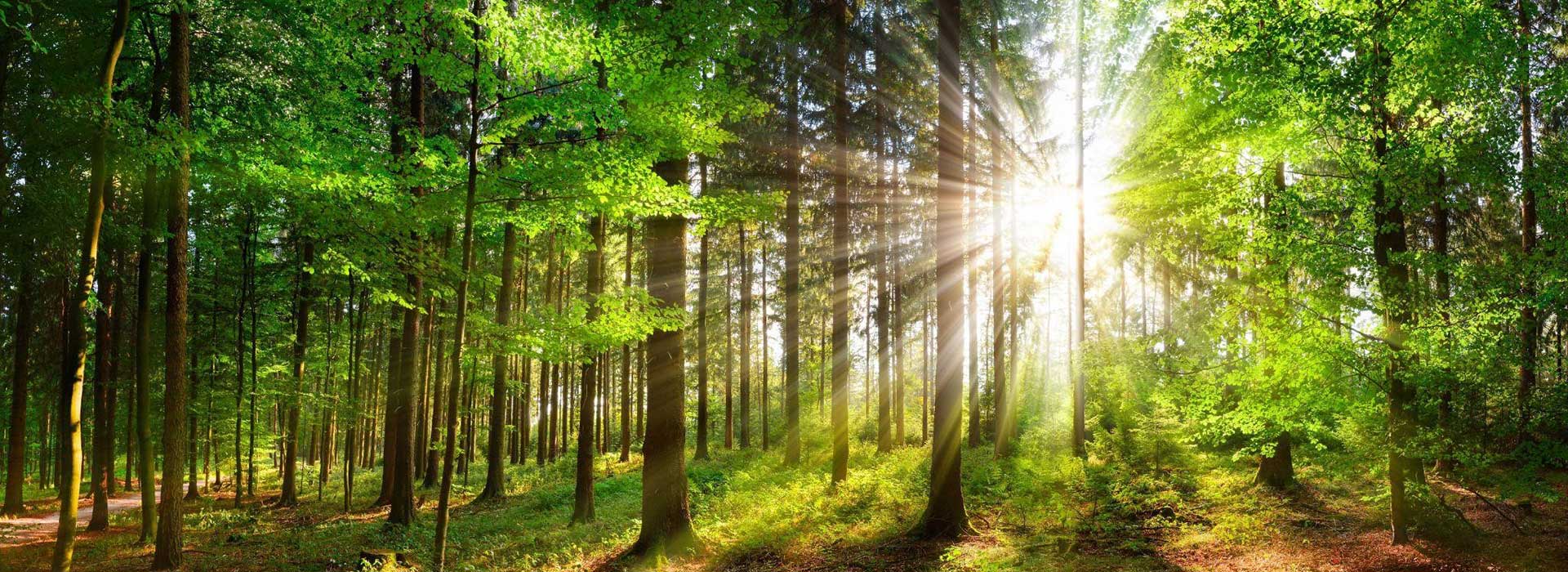Reforestation around the globe can provide an excellent opportunity to reduce carbon dioxide levels in our atmosphere, mitigating the effects of climate change and global warming. It can also aid in forest restoration in areas that have been affected by wildfire.
Reforestation has several positive impacts on ecosystems and our planet as a whole. Benefits include carbon sequestration, improving biodiversity in wildlife habitats, and increasing soil fertility. Reforestation can help us restore our planet’s health moving into the future.
Today, we’d like to answer any question you might have surrounding the process of reforestation. Below, you’ll learn about the importance of reforestation, the positive impacts it has on the environment, and what it takes for reforestation to happen.
What Is Reforestation, and Why Is It Important?
Reforestation is the process of replenishing forest land that has been depleted of its trees. Tree planting is an effective form of carbon offsetting; that is why it is so important to replenish and protect forest land.
Forests can lose trees in a number of ways. Natural disturbances like wildfires are a common threat to forests. Plus, human practices like logging for timber, clearing land for agricultural reasons, and urbanization cause deforestation.
Whether deforestation has occurred due to human activity or a natural cause, it is important to restore the condition of forests. Forests play a key role in Earth’s natural carbon cycle, acting as one of the ecosystems that absorb carbon from the atmosphere. These carbon-absorbing ecosystems are called “carbon sinks” and include forests, the ocean, and soil.
Each year, forests alone absorb one-third of carbon dioxide emitted from burning fossil fuels. As more deforestation occurs, less carbon dioxide is absorbed from the atmosphere.
What’s more, the land sector is responsible for 25% of global greenhouse gas emissions that contribute to climate change. The activity of forest degradation is responsible for half of these emissions. The very process of deforestation causes a substantial amount of carbon emissions, while simultaneously destroying one of Earth’s abilities for natural regeneration.
Deforestation is a serious issue amid the climate crisis. Luckily, forest restoration is a great climate change solution, and according to one study conducted at a university in Switzerland, it is our best bet when it comes to countering increasing global temperatures and carbon dioxide levels.
What Are the Benefits of Reforestation?
Reforestation has many benefits. Reducing carbon and slowing the effects of climate change are two of the most important benefits. In areas that suffer from poor air quality, planting new trees in the region can reduce air pollution.
The soil itself will be healthier and contain more nutrients.
Other benefits include the restoration of natural habitats that improve biodiversity in both flora and fauna. Communities can benefit from reforestation efforts as forest products are replenished and jobs are created.
Let’s go over these benefits in more detail:
- Climate change and carbon mitigation: As mentioned above, trees and forests are responsible for absorbing carbon dioxide. They can hold carbon in their branches, trunks, and roots for a long time with proper forest management. This storage of carbon can help to combat climate change.
- Cleaner air: Trees can absorb air pollutants through their leaves. They can filter out air contaminants like carbon monoxide, sulfur dioxide, and nitrogen dioxide. Planting new trees can help polluted regions improve air quality.
- Protects water sources and soil fertility: Soil erosion can contaminate water sources and fill reservoirs, rivers, and streams with sediment. Tree roots hold the soil in place, preventing mudslides and other general soil erosion from occurring. A healthy canopy provides good forest cover and prevents rain from falling directly on the ground, limiting erosion. Trees can keep the soil cool, allowing it to maintain its moisture content and remain fertile. The roots can also bring water to the surface from deep underground water sources, keeping the soil moist.
- Habitat restoration and improved biodiversity: Replanting forests or planting new forests with a diverse number of tree species can help to restore habitats and promote biodiversity of both plant and animal species. Many animals have lost their habitats due to urbanization and deforestation for agricultural needs. Restoring these lands can allow for ecosystems to heal naturally.
- Forest products and improved economies: Reforestation will enable us to responsibly use natural resources by replanting trees that have been harvested for use. One acre of conifer forest would yield around 7,000 board feet of lumber in only 50 years. And that still leaves 30,000 board feet to continue growing in reserve. Reforestation also helps economies by providing jobs. Research finds that in the United States, nearly 40 jobs could be created per $1 million spent on reforestation programs.
When Did Reforestation Start?
In 1897, The Organic Administration Act allowed for the creation of national forests in the United States. The goal was to protect forests, secure water flow, and supply timber. Reforestation was needed to meet these goals and was conducted in the early 1900s primarily as a response to large forest fires.
In 1930, the Knutson-Vandenberg Act ensured that the cost of reforestation is covered when timber is sold from a harvest on national forest land. The act also arranged for the creation of tree nurseries in national forests.
For the first half of the 1900s, trees were harvested selectively from national forests and allowed to naturally regenerate. Starting in the 1960s, tree harvesting switched to regeneration methods like clearcutting.
Clearcutting fell out of favor in the 1990s, and timber sales under the Knutson-Vandenberg Act decreased, resulting in fewer funds available for deforestation needs. Most of the deforestation needs we see today are in response to intense wildfires caused by a buildup of highly flammable fuels over the last 100 years.
What Is the 1 Trillion Tree Reforestation Plan?
In 2020, a global platform called 1t.org was launched to conserve and plant 1 trillion trees by the year 2030. The United States chapter of this global movement to restore forests and protect forest land was created through a collaborative effort between the conservation organization American Forests, the U.S. government, and the World Economic Forum.
An independently operated council that is comprised of members across many Federal agencies exists to streamline the process of reforestation and to overcome any obstacles that might prevent planting new trees. The council has the potential to make a big difference in the Trillion Tree Initiative, with the United States holding around 8% of the world’s forest land and possessing the knowledge and resources to help global communities in the process of reforestation.
The platform 1t.org aims to facilitate reforestation by involving the private sector, promoting multi-stakeholder partnerships in specific regions, and backing eco-driven innovation. The organization consists of a global advisory council that aids in the initiative’s direction and aims to meet stakeholders’ needs.
The goal of planting 1 trillion trees is based on research evidence that Earth now only has half of what was once a global number of about 6 trillion trees before the agricultural revolution occurred. The study finds it is possible to reforest 2.2 billion acres of land by planting 1 trillion to 1.2 trillion trees.
The organization is concerned with planting new trees and endeavors to conserve standing trees. The goal of 1 trillion trees by 2030 can be met by conservation efforts that protect existing forests, limit deforestation, restore forests that have been damaged, and practice growing the right tree species in the right places.
Each entity involved in the plan is responsible for participating in responsible reforestation. Native trees will be planted in areas where they belong to promote healthy ecosystems and improve the survival rate of saplings.
What Is Needed for Reforestation?
Reforestation needs are met through global involvement in the process, understanding effective reforestation methods, and considering the cost of reforestation.
Nations around the globe, regional governments, local communities, and individuals must involve themselves in reforestation for the process to work. Once these entities get behind the idea of forest conservation and restoration, proper forestry practices must be followed to plant new trees effectively. Projections of what it might cost to meet the needs of reforestation will help governments and organizations make the necessary preparations to achieve their goals.
Global organizations are the best option for promoting education and responsible practices surrounding reforestation. When communities around the globe can come together for the common benefit of Earth’s ecosystems and forests, we will see the positive effects reforestation can have on our planet.
Responsible reforestation techniques include the cultivation of tree stands, clear cutting for new growth, allowing natural seeding to occur, and planting trees in strategic areas.
In some cases, patches of old trees are cut to make room for new trees to grow. Some tree species cannot grow in the shade of their older neighbors and, therefore, need land to be clear cut for them to grow.
Sometimes certain mature trees are left in a clearcut area. This allows these mature trees to seed the land surrounding them, promoting new growth through natural seeding. Sometimes trees are left in a cleared area to provide shelter for saplings to grow.
Reforestation costs can vary depending on the region, the methods needed to reforest, and the number of trees that need to be planted in an area.
A study breaks down the cost of reforestation per hectare in various regions of the United States. The price is about $788 for the southern region, $1,058 for the western region, and $2,098 for the eastern region. The study finds that 26 million hectares of land in the U.S. provide good opportunities for replanting, and the total cost of planting this entire area would be around $33 billion.
Where’s all that money going? The U.S. forest service breaks down its expenses: 50% for the planting crews, 29% for preparing planting sites, 15% for seedlings, and 6% for post-planting studies and observation.
While a lot goes into reforestation, the benefits of protecting the Earth’s forests are well worth it. If nations and individuals around the globe can come together to plant trees responsibly, the benefits for the environment will be significant.
Reforestation Practices for the Future
Reforestation is one of the best opportunities to fight against carbon levels and climate change. Benefits like improved air quality, protected water resources, and enhanced soil conditions are some of the reasons we should consider reforestation as a conservation method moving into the future. Plus, natural habitats can be restored, boosting biodiversity in areas that have been affected by deforestation due to wildfire or human activity.
The practice of planting trees has been around for some time, and now we need to expand reforestation on a global level to reach a number of trees that can help us restore tree concentrations around the world.
You can contribute today by signing up for a Carbon Balanced Living Plan that offsets your carbon-producing activities. The plan provides funds for reforestation projects, along with other projects that remove carbon emissions from the atmosphere.
Brought to you by terrapass.com
Featured image













